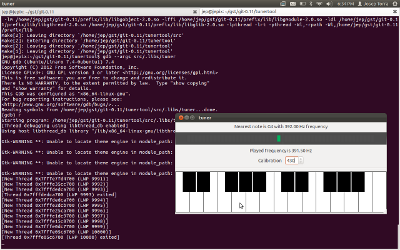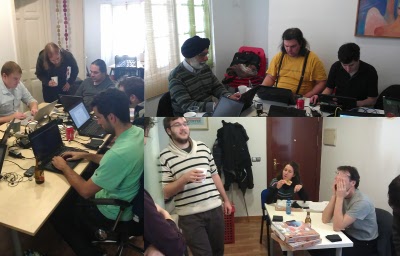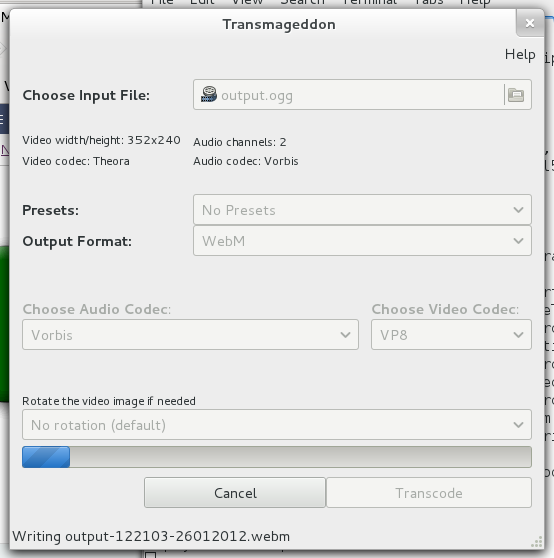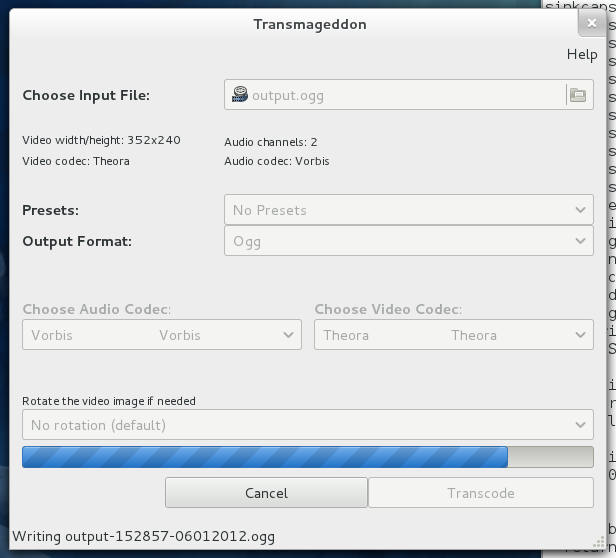So working up to MWC in Barcelona this week we just announced a great new effort by Collabora and Fluendo around the GStreamer project. The goal is to ease adoption of GStreamer by making sure that no matter what platform you are in, there are well tested and easy to install and use binaries of GStreamer available. This means that not matter if you are running Windows, MacOS X or Linux, you will have a GStreamer SDK available to use. Eventually we will also cover various embedded platforms with this SDK, making it easier than ever to use GStreamer to create great cross platform multimedia applications. You can find out more about this effort by checking out the press release which have all the relevant details.
Category Archives: GNOME
A day in my life with the GNOME Shell
So I have been using the GNOME shell for quite some time now, and I guess like any desktop experience it has its ups and downs, but at least I think I reached a stage where my remaining quibbles with the GNOME Shell is related to how it works as opposed to irritations caused by me being used to something else. One thing I keep asking myself is if GNOME Shell has in any way made me more or less productive, my guess is that the change has been mostly productivity neutral once I got used to the new setup.
That said I have some smallish irritations with the GNOME Shell, the biggest being that the menu system feels slow, it feels distinctly slower than GNOME 2.x to click into Activities->Applications->Category to get to the application I am looking for, especially if I haven’t done so in a bit and the icons have to be pulled from disk. Also the fact that the categories is on the right side of the screen means a long mouse journey across the screen to get to the categories, and then a long mouse journey usually back towards the left side of the screen to click on the application I want. Ok, so this is not an operation I perform every 5 minutes, but still it feels a bit to laborious for what it is.
The other frustration I have is with the notification dock at the bottom of the screen, but I suspect this is mostly application issues. Like for instance gtimelog seems to have a different behaviour if you click on the text or the icon, and with the icon being so small I sometimes overshot, which causes the irritation of having to move a ‘long’ way back to due the neighbouring icon having expanded. Other small irritations includes the the Banshee icon saying ‘notify-sharp’ instead of Banshee and getting a ton of notification messages on the status bar as peoples IM client set them to offline/away etc.
Hmm, actually having written my irritations down I do feel they feel rather small and insignificant, yet if someone sees this I hope these items will be improved upon for future versions.
Also I do think that the system menu should offer shut down/restart by default, if I hadn’t seen someone mentioning it on IRC some Months back I am sure I to this day wouldn’t have realized I could press ‘alt’ to get shutdown/reboot to appear in the menu. I know there is an extension now, but it is such a basic operation that should require knowing ‘secret’ buttons getting an extension.
Summary of GStreamer Hackfest
So as I talked about in my last blog post we had a great GStreamer hackfest. A lot of things got done and quite a few applications got an initial port over to 0.11. For instance Edward Hervey ended up working on porting the Totem video player, or rather trying to come up with a more optimized design for the Clutter-gst as the basis port was already done.
Another cool effort was by Philippe Normand from Igalia who put a lot of effort into porting WebKit to use 0.11. His efforts where rewarded with success as you can see in this screenshot.
Jonathan Matthew had flown up all the way from Australia and made great progress in porting Rhythmbox over to the 0.11 API, a port which became hugely more useful after Wim Taymans and Tim-Phillip Muller fixed a bug that caused mp3 playback not to work :).
Peteris Krisjanis made huge strides in porting Jokosher to 0.11. Although like Jason DeRose from Novacut and myself on Transmageddon he did end up spending a lot of time on debugging issues related to gobject-introspection. The challenge for non-C applications like Jokosher, Novacut, Transmageddon and PiTiVi is a combination of the API having changed quite significantly due to the switch to gobject-introspection generated bindings, some general immaturity challenges with the gobject-introspection library and finally missing or wrong annotations in the GStreamer codebase. So once all these issues are sorted things should look a lot brighter for language bindings, but as we discovered there is a lot of heavy lifting to get there. For instance I thought I had Transmageddon running quite smoothly before I suddenly triggered this gobject-introspection bug.
There was a lot of activity around PiTiVi too, with Jean-François Fortin Tam, Thibault Saunier and Antigoni Papantoni working hard on porting PiTiVi to 0.11 and the GStreamer Editing Services library. And knowing Jean-François Fortin I am sure there will soon be a blog with a lot more details about that :).
Thomas Vander Stichele, who also wrote a nice blog entry about the event, was working with Andoni Morales Alastruey, both from Flumotion, on porting Flumotion to 0.11, but due to some of the plugins needed not having been ported yet most of their effort ended up being on porting the needed plugins in GStreamer and not so much application porting, but for those of you using plugins such as multifdsink, this effort will be of great value and Andoni also got started on porting some of the non-linux plugins, like the directsoundsink for Windows.
Josep Torra from Fluendo ended up working with Edward Hervey on hammering out the design for the clutter-gst sink at the conference, but he also found some time to do a port of his nice little tuner tool as you can see from the screenshot below.
George Kiagiadakis kept hammering away at the qtGStreamer bindings, working both on a new release of the bindings for the GStreamer 0.10 series, but also some preparatory work for 0.11.
In addition to the application work, Wim Taymans, Tim-Phillip Müller and Sebastian Dröge from Collabora did a lot of core GStreamer clean ups and improvements in addition to providing a lot of assistance, bugfixing and advice for the people doing application porting. All critical items are now sorted in 0.11 although there are some nice to have’s still on the radar, and Wim plans on putting out some new releases next week, to kickstart the countdown to the first 1.0 release.
As for my own little pet project Transmageddon, it is quite far along now, with both manually configured re-encodes and profile re-encodes working. Still debugging remuxing though and I am also waiting for the deinterlacer to get ported to re-enable deinterlacing in the new version. For a screenshot take a look at the one I posted in my previous blogpost.
GStreamer Hackfest in Malaga update
Things have been going really well here at the GStreamer Hackfest in Malaga. Thanks to the help of Ara and Yaiza from Nido Malaga, we have a great venue in downtown Malaga and they have also helped us greatly with sorting out food.
We have a great group of people here and are making great progress, and by tomorrow I hope we will have screenshots of quite a few applications running with GStreamer 0.11, for instance both Rhythmbox and Jokosher for instance is already screen shootable, if not fully functional :)
Also making good progress on Transmageddon, even if the move to GObject Introspection bindings are making things a bit more complicated. Screenshot below of the progress so far.
Also a big thanks to Fluendo who is sponsoring the lunches at the hackfest and Collabora who is sponsoring tonight’s dinner. Ensuring that no hacker is left hungry during this hackfest.
Update: Yaiza took these photos from the hackfest
Interview with Arun Raghavan about PulseAudio
With all the talk generated by Arun Raghavans blog post comparing PulseAudio and Audioflinger I thought it would be good to follow up with an interview with Arun about the latest developments in PulseAudio and the way forward for the project. You can find the PulseAudio interview here. I also made a new page listing all the Collabora developer interviews done so far. Enjoy :)
GStreamer Hackfest in Malaga
Tomorrow I will be heading off to attend the GStreamer Application Porting Hackfest in Malaga, Spain. I think we have managed to pull together an absolutely incredible group of people for this event and I have great hopes that by next weekend we will have squashed a ton of bugs in GStreamer 0.11/1.0 and also have initial ports of a long range of important applications and bindings. This is the first time in GStreamer history that we are trying to hold a hackfest focused on application developers, but hopefully it will be the first of many and that they can become a good way for the core GStreamer community and the application development community to interact and collaborate more closely.
Also want to say a special thanks to the community members attending the event on their own and also to the companies sending their employees to the hackfest; Collabora, Fluendo, Flumotion and Igalia and finally a special thanks to the GNOME Foundation for sponsoring some of the attendees.
Hopefully I will be able to post some screenshots of a fully functional GStreamer 1.0 Transmageddon next weekend :)
Transmageddon runs with GStreamer 0.11
After updating GStreamer and doing a couple of small fixes I managed to make Transmageddon work with the GTK3 and the 0.11 branch of GStreamer. Obligatory screenshot below. As you might guess from looking at the screenshot there are still some issues that needs solving, but
I am happy that I managed to get this far.
Hopefully it is a sign that the upcoming GStreamer hackfest in Malaga will be a great successful everyone who is participating.
I hope the remainder of the porting effort will be relatively simple as I would love to get back to working on real features instead of just updating old functionality to use a new backend to do the same. Having had a need for Transmageddon for a couple of work related tasks recently a couple of items, like batch job programming has moved up my priorities list.
Gustavo Noronha Silva Interview about WebKit
Just posted another interview on the Collabora website, this time with Gustavo Noronha Silva talking about WebKit and some of the work he and Collabora are doing around that project. So be sure to check it out if you want to learn more about things like WebKit and Clutter integration and how WebKit impacts the GNOME platform.
GStreamer 1.0 Application porting hackfest/code sprint
We are trying to put together a hackfest to help developers using GStreamer to port their applications to GStreamer 1.0. The GStreamer Hackfest/Code Sprint 2012 will take place in Malaga, Spain, between 25th to 27th of January (3 full days). I would ask all developers out there interested in attending to add your name to the wiki as quickly as possible, just so we can estimate interest. If you are interested, but don’t know for sure if you can make it there, it would still be good if you added your name with maybe a comment mentioning that you need to verify before you are certain.
We will be offering some travel sponsorship, so even if you are short on cash we hope to have you attend, more details on the hackfest&codesprint wiki page.
For those wondering why we choose Malaga, well the reason is that Wim Taymans, the GStreamer 1.0 designer and lead developer lives there, and at a previous hackfest we tried to do in Oslo he ended up in Helsinki instead. So this time we are taking no risks, but instead we are taking the hackfest to him :)
Farstream and libnice, an interview with Youness Alaoui
After the success of the GStreamer interview with Wim Taymans I thought we follow up with another great interview with a Collabora developer.
This time we are talking with Youness Alaoui who is one of the maintainers of Farstream, the audio and video conferencing framework built on top of GStreamer. We also cover another of Youness Alaoui projects, libnice, the NAT traversal library. So if you want to know what is happening with audio and video conferencing on Linux be sure to read the full interview with Youness Alaoui here.




